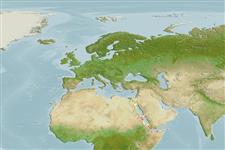Classification / Names
Common names from other countries
Main reference
Size / Weight / Age
Max length : 40.0 cm TL male/unsexed; (Ref. 30573)
Environment
Marine; reef-associated; depth range 1 - 40 m (Ref. 27115), usually 5 - 40 m (Ref. 27115)
Climate / Range
Tropical; 25°C - 27°C (Ref. 27115), preferred ?
Distribution
Short description
Dorsal
spines
(total): 9;
Dorsal
soft rays
(total): 24-28;
Anal
spines: 3;
Anal
soft rays: 23 - 26. Characterized by having 2 longitudinal bands on the side, one from the hind margin of the eye posteriorly, another from the groove around the caudal peduncle spine anteriorly. Juveniles of less than 5 cm SL lack the anterior band; less than 10 cm SL lack the posterior band. Reaches 24 cm SL.
IUCN Red List Status (Ref. 115185)
Threat to humans
Harmless
Human uses
Aquarium: commercial
More information
ReferencesAquacultureAquaculture profileStrainsGeneticsAllele frequenciesHeritabilityDiseasesProcessingMass conversion
Tools
Special reports
Download XML
Internet sources
Estimates of some properties based on models
Phylogenetic diversity index
PD50 = 0.5000 many relatives (e.g. carps) 0.5 - 2.0 few relatives (e.g. lungfishes)
Trophic Level
2.8 ±0.28 se; Based on food items.
Resilience
Medium, minimum population doubling time 1.4 - 4.4 years (Preliminary K or Fecundity.)
Vulnerability
Low to moderate vulnerability (32 of 100)
Price category
